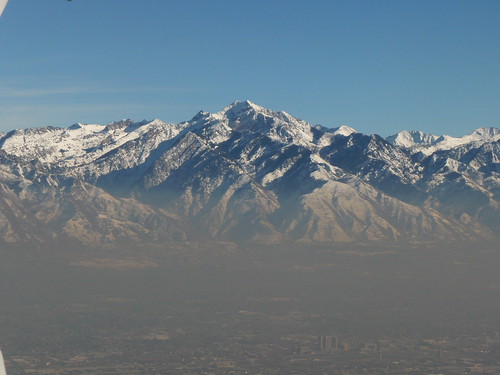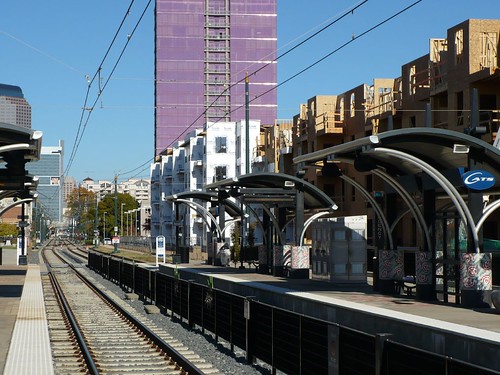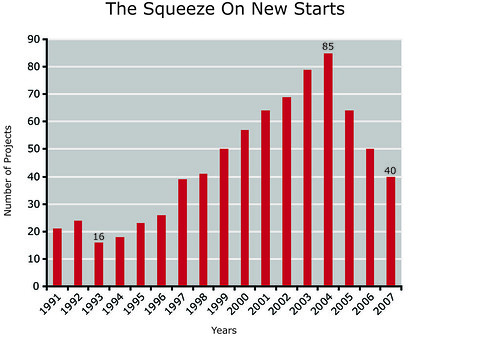Last week, Yonah Freemark wrote a post discussing the benefits of fast transit specifically calling out the Green Line in Minneapolis for running 11 miles in about an hour. Now, this line has parts of what people are always asking streetcars to have; dedicated lanes. "They get stuck!" Yet this line, as well as the T-Third in San Francisco and others mentioned in the post are still "too slow". Yonah goes on to discuss metro expansion in Paris leaving a discussion of politics and costs of rapid transit to the very end.
To me this points to the first place where urbanism and fast transit disagree with each other, block sizes and stop spacing. By trying to maximize connections to the community, the transit line has to stop more often, slowing speeds. And if built into a legacy urban fabric, this also includes negotiation with tons of cross streets where designers don't give priority to the transit line. This happens in Cleveland on the Health Line BRT as well as the Orange Line in Los Angeles, even though it has its own very separated right of way. The Gold Line Light Rail in LA and the Orange Line originally had the same distance, yet one was 15 minutes faster end to end. A lot of this had to do with less priority on cross streets given to the Orange Line, not because it was a bus or rail line.
We continue to talk as if dedicated lanes are magic, but its a suite of tools that helps speed transit along inside of our wonderful urban fabrics. Transit is directly affected by urbanism, if we let it be.
But then there is the other side of this discussion. Transit's effect on urbanism. Some New Urbanists believe that slow transit is necessary for building better urbanism. Rob Steuteville of New Urban News calls this "Place Mobility". The theory goes like this:
When a streetcar -- or other catalyst -- creates a compact, dynamic place, other kinds of mobility become possible. The densest concentrations of bike-share and car-share stations in Portland are located in the area served by the streetcar. That's no coincidence. You can literally get anywhere without a car.In Portland parlance, this is the "Trip Not Taken". When you build up the urban fabric of a city, many usually induced trips disappear. That car trip to the grocery store becomes a walk and that streetcar trip to Powell's Books might be a bike trip now. Or in the world of the web, that trip might change hands, from you to the delivery truck. In Portland at the time they calculated a 31 million mile reduction in VMT from the housing units built along the streetcar route.
To increase the viability of streetcars in a world dominated by a "cost effectiveness" measure dependent on calculations of speed, the "Trip Not Taken" was refreshing. Many transit lines were being built without regard to neighborhood or were cheap and easy. But they were fast! You can see how the "cost effectiveness" measure intervened with elevated rail through Tyson's Corner (yes I'm still annoyed) or the numerous commuter rail lines on freight rights of way in smaller regions that probably should never have been built. But they were fast!
Yes the streetcar helps with creating place in the minds of developers and urban enthusiasts, but no it doesn't do the whole job. The Pearl District and Seattle's South Lake Union were perfect storms of huge singular property ownership, massive investments in additional infrastructure, proximity to a major employment center, lack of NIMBYs, and a strong real estate market. But look at the results. It's hard to argue that the streetcar didn't help develop this massively successful district in one of planning's favorite cities. But it's also hard to give it all the credit.
The crux of the argument is that place making should be the ultimate goal and slowing things down makes things better. And many cities see the streetcar as some sort of fertilizer that makes it grow and a reason to change zoning code. Because of very stringent local land use opposition (read NIMBY), this makes a lot of sense. If a streetcar can lead to the restructuring of land use or the fulcrum of a district revitalization, I see that as a benefit. But again, don't give it too much credit.
From a safety standpoint this slowing down idea makes sense. The Portland Streetcar has been in collisions, but no one has died or been seriously hurt, unlike a number of high profile collisions in places like Houston, where drivers can't seem to follow the rules. Our society also puts up with over 30,000 deaths a year to get places faster on interstate highways as well.
But...
Ultimately the base success of a transit line isn't in the amount of development it has spurred or the zoning it has changed. It's the ability to get a lot of people where they want to go, in a timely fashion. A commenter on Jarret Walker's Human Transit Blog says it best.
But the romantic impulse towards slow transit wears away quickly if you have no choice but to rely on it all the time! I don't have a car, so I rely on buses that travel excruciatingly slowly, wasting much of my time.As someone who has gotten rid of my car and considers myself a walking, bike riding, transit loving (and sometimes zipcaring) urbanist, I find it very annoying that it takes an hour to go three miles here in San Francisco on the bus. And if I need to get downtown, I take the Subway which is a half mile away versus the streetcar which is half a block away because time does actually matter. We see this decision play out every day when people choose to drive cars over using transit.
But if we are going to spend so much money, we might as well figure out a way to transport the most people possible. Sometimes that might be streetcars. Other times it's not.
But back to urbanism and transit.
In Portland, dedicated lanes on the North/South parts of the line wouldn't make as much difference because it has the same issues we mentioned with the Green Line above and narrow streets. Streetcars have to deal with urbanism. I think streetcars are ok as a circulator in downtowns, because these are the trips that help people get around dense places that are proximate. You can bring your groceries on when its raining and disabled folks can load their wheelchairs with dignity. Tourists like the certainty of the tracks and little kids love the ride. We see that even on 20 minute headways, 13,000 riders are on the line every day. It's hard to argue with that, given it's more riders than many first choice bus lines in some major cities without rail.
However for linear route based transit operations, we need dedicated lanes and signal priority to at least make the expenditure worthwhile and play nice with our urbanism. Once you get outside of a district, people want to get places. I like subways and wish we had more, but it seems politics and money seem to get in the way like Yonah mentions above. Some might even argue that before we even think about building fixed guideway lines, we should focus on our buses. Perhaps we should have a threshold system ridership before putting in rail, to determine whether all options for increasing ridership have been exhausted. Houston's new network plan could be a good guide. And personally, I don't think BRT should be special. It should be the norm. Luckily the new 5339 bus facilities funding guidance could allow for BRT and Rapid Bus funding (they are NOT the same thing).
But there's a new report out which discusses which factors drive ridership for fixed guideway transit once we decide to go that route. Employment and residential density around transit lines, the cost of parking downtown, and grade separation were found to be the most effective measures when put together to drive ridership according to a recent TCRP report released earlier this month. Individually employment had an r squared of .2 while the others had negligible impacts. Only taken together as a whole did these measures drive the most ridership as seen below.
The report goes on to say "The degree of grade separation is likely influential because it serves as a proxy for service variables such as speed, frequency, and reliability that may lead to greater transit ridership."
But determining success is hard. In fact, its so hard that of the transit projects surveyed, the only thing that transit agencies seemed to agree on (it has dots in every project below) was that the line would be cheap! We discussed this briefly above.
"Provide fixed guideway transit in corridors where inexpensive right of way can be easily accessed"Which is many times why we end up with slow transit. It's cheap. We're cheap. Streetcar costs are below that of light rail or subways and since its in a mixed traffic right of way, it will be cheaper politically than BRT. Commuter rail on freight rights of way is the best to them though even though its the worst at creating ridership. To me it's is even cheaper because it usually ignores the chart above with the focus on employment and residential density.
So all of this is to say that Streetcars are not the worst transit ever and urbanism will affect transit, and transit will affect urbanism. We just need to decide what the appropriate ways are for intervention such that we maximize people's ability to get to the places they want to go and build great communities. Let's not swing the pendulum too far to either side, it might tip the balance against us.






